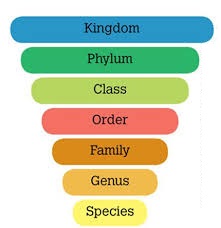- The rhizoids as in moss plant
- Fronds in ferns
- The type of root; tap root, adventitious, fibrous, prop, buttress roots.
- Stem presence and type.
- Presence or absence of flowers
- Type of leaves; simple or compound; leaf venation- parallel or net work veined.
- Presence and types of fruits and cones.
- Tentacles in hydra
- Body covering- feathers, scales, hair or fur
- Shells in snails
- Wings in birds
- Proglotids in tapeworms
- Mammary glands in mammals
- Locomotory structures
- Body pigmentation
- Taxonomic units of classification refer to the groups or taxa into which organisms are placed as a matter of convenience.
- Grouping of organisms in these groups is based on easily observable characteristics that are common in that group.
- Living organisms which share a lot of characteristics are placed in the same group.
- Each taxonomic unit reflects the position of an organism in relation to the others in the classification scheme.
- In a classification scheme, a hierarchy of groups is recognized and it proceeds from the first largest and highest group, the kingdom to the smallest and lowest unit, the species.

a) Kingdom Monera - This is composed of microscopic unicellular organisms mainly bacteria
b) Kingdom Protoctista - This kingdom is comprised of members who are microscopic. Though, some are large enough to be seen with the naked eyes.
Members of this kingdom include algae and protozoa e.g Amoeba
c) Kingdom Fungi - Members of this kingdom comprises the mushrooms, toadstools, moulds and yeast.
d) Kingdom Plantae - This kingdom comprises the moss plant, ferns, maize plants, hibiscus, meru oak tree etc.
e) Kingdom Animalia – Members of this kingdom include the tapeworms, hydra, fishes, human beings, lizards, earthworms etc.
- In hierarchy of classification, a kingdom is further divided into several phyla (plural of phylum) or divisions (in plants).
- Within the phyla or divisions, organisms are further sorted out into groups known as classes based on their similarities and mode of life.
- Each class is further subdivided into small groups called orders based on structural similarities.
- Orders subdivide into families which are subdivided into genera (plural for genus).
- Genera are then subdivided into smaller units of classification called the species.